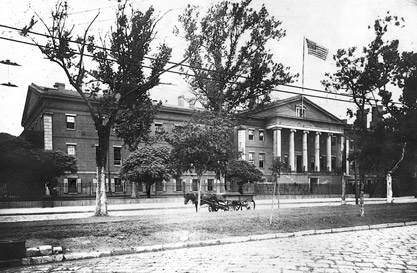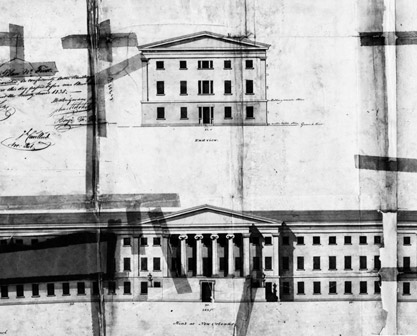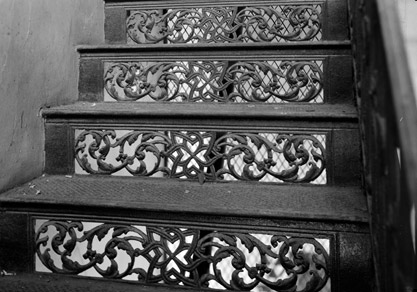New Orleans Mint exterior view c. 1900.

New Orleans was the largest of the early mints. The reasons for this are suggested by its location at a major port of entry to the United States and the fact that the city was known as the emporium of the Great Valley, with considerable quantities of gold coming from Mexico. Furthermore, as one scholar notes, "The Southern mints were the result of [President Andrew] Jackson's long war with the Bank of America and paper money". Jackson had considerable personal ties to New Orleans, as well.
New Orleans Mint floorplan drawing by architect William Strickland.

First floor plan of the New Orleans Mint. Note the plazzas on the L-shaped wings. Architect William Strickland was paid $300 for a series of floorplans, elevations,
Drawing of exterior elevations of the New Orleans Mint

During the Civil War the Mint was occupied by Confederate forces and produced coins for the Confederate States. Coining for the United States resumed in 1879 and continued until 1909, when other mints, such as San Francisco, rendered the New Orleans facility obsolete. An assay office operated in the building until 1931 when it was converted to a prison to handle Prohibition violations. In 1934 the prison was shut down and the Coast Guard took over the building. Finally, in 1979 the building was transferred to the State of Louisiana for use as a museum. Today, as one author states, "The New Orleans Mint building exhibits few of the problems that plagued it during its tumultuous decades of service. It stands as a testament to man's ingenuity and frailty."
New Orleans Mint interior cast iron stairs detail

Preservation was a concern with the New Orleans Mint, simply to keep the building standing, from the beginning. Apparently Strickland s structural design was better suited to the firm ground of Philadelphia than to the soft New Orleans soil. From the 1840s through 1860s, structural repairs were ongoing. The long time between the end of the Civil War and the building s reopening in 1879 was due in large part to repairs which required larger appropriations than were available during the Reconstruction era. In 1869 Alfred Mullett went so far as to call for the sale of the building to the city since it was little more than a source of expense to the government. The 1965 transfer of ownership from the General Services Administration to the state was assured by Louisiana's plan to restore the landmark building. One scholar, writing in 1970 before the Museum transformation, said that "...many proposed uses for the building...are a violation of the integrity and character of the Mint... The Mint must be preserved as a logical and integral part of the historical resources of the State of Louisiana".
